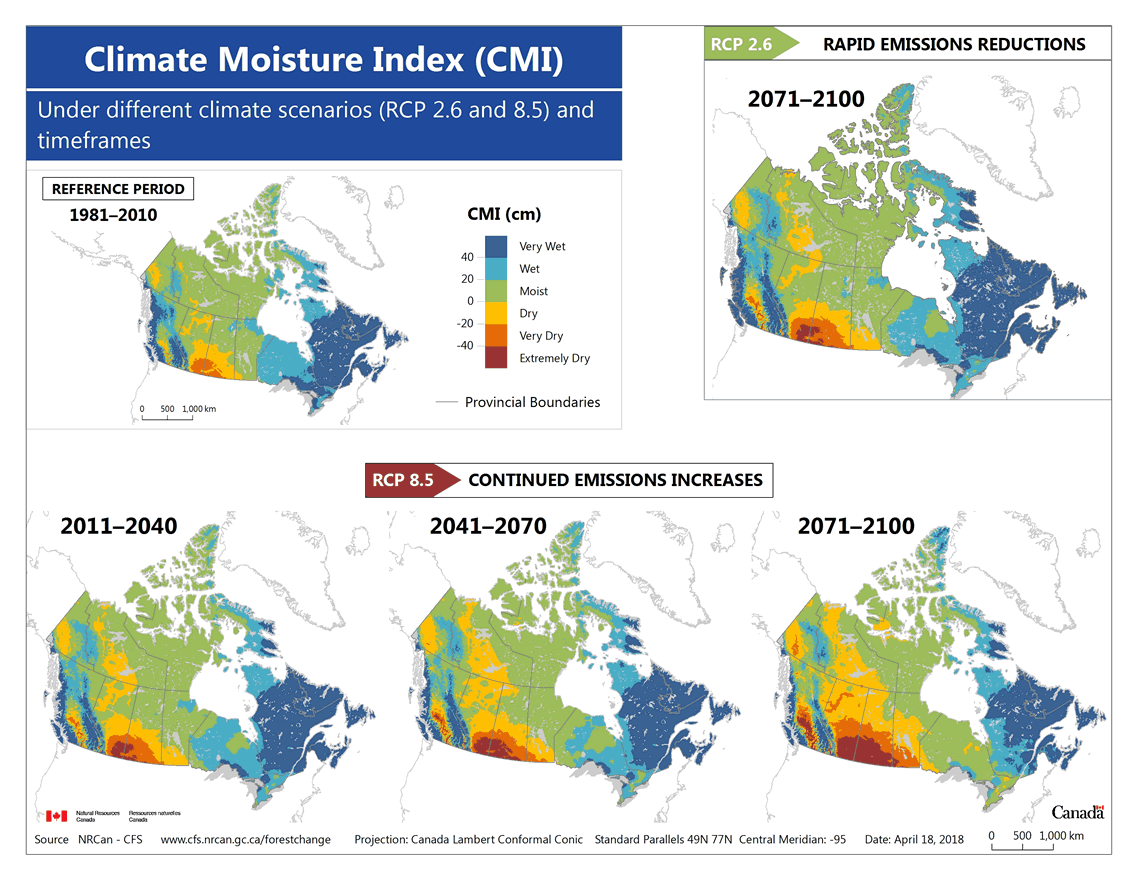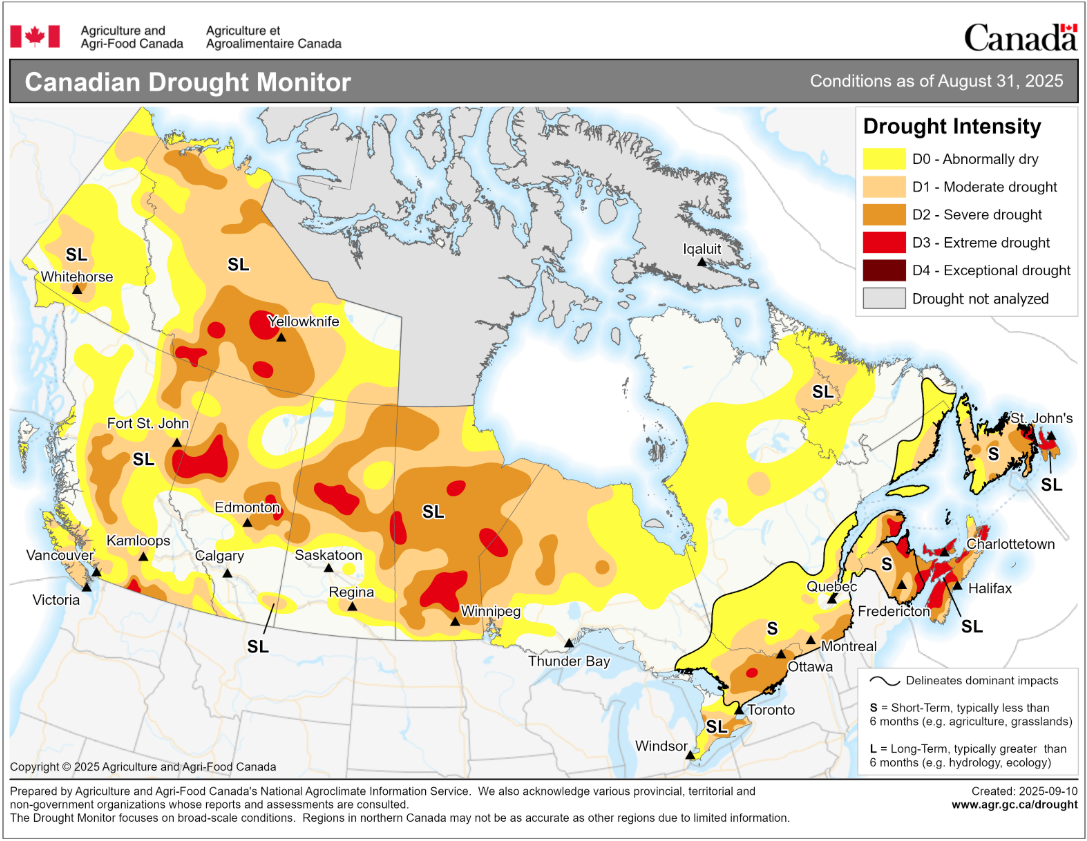Drought

What is a drought?
Drought is expected to become more frequent and severe in parts of Canada.
Drought is defined as a shortage of precipitation over an extended period, usually a season or more, resulting in insufficient water availability that adversely impacts vegetation, animals and people.
Areas of western Canada are already experiencing frequent and severe droughts. Scientists expect new areas across the country to be affected and drought to become even more frequent and severe. The consequences could have far-reaching impacts on Canada’s forests.
Why knowing about drought is important
Drought threatens Canada’s forests by limiting the available water that trees need to survive. When water is limited, trees become weakened. Weakened trees cannot grow at a normal rate, may not be able to regenerate, or could die. It is also difficult for trees to defend themselves against insects and diseases as they become stressed. Similarly, during wildland fires, weakened trees are at higher risk. For the Canadian forest industry, these issues directly affect the available wood supply.
Canadian Forest Service researchers have developed a measure of drought called the Climate Moisture Index (CMI). CMI is calculated as the difference between the annual amount of precipitation and the expected amount of water that evaporates each year and can be used to indicate the amount of moisture available in a given year.
Tracking drought helps forest managers anticipate and manage for a changing climate. For example, the SeedWhere program can be used to predict where similar climates will be located under a range of future climate scenarios and timeframes. Forest managers can use this tool to select the planting stock (e.g., species and provenance) that is best adapted to predicted drought conditions.
What has changed
Several regions of Canada experienced substantial droughts between 1951 and 2010, but with significant variability between decades. However, during the first decade of the 21st century (2001–2010), exceptional droughts were observed across the country – for example, the 2001–2002 drought in the Prairies caused abnormally high aspen mortality (see Tree mortality).
Similar trends have been reported in forests around the world. With droughts expected to become more frequent and severe in most of Canada’s forests, there are growing concerns about the impact of drought on forest distribution, tree health and regeneration success.
The outlook
Increases in drought could have far-reaching impacts on Canada’s forests, both directly, through impacts on tree growth and survival, and indirectly, through drought-related increases in the frequency of disturbances such as fire and insect outbreaks.
Drought is expected to become more frequent in several areas that are already relatively dry, such as the southern interior of British Columbia and the Prairie provinces.
Some areas that have not previously experienced frequent drought are also expected to become drier in the future. The current prairie conditions are expected to spread northwards into areas of the southern boreal forest. Such a shift would lead to significant changes in forest ecosystems.
Moist regions, such as the Pacific and Atlantic coastal areas, are expected to be less affected, with limited changes in annual climate moisture index (CMI) values over the next 100 years. However, these moist areas could become more prone to the impacts of seasonal droughts even if the annual CMI indices remain positive.

This information is sourced from Natural Resources Canada. For additional information regarding droughts, please go to: Natural Resources Canada
Water shortages: safety information for well owners
In the summer and fall, Nova Scotians may experience water shortages because of unusually warm and dry conditions. During a shortage, you may need to take extra steps to make sure you have safe drinking water.
During a water shortage, everyone should do their part to conserve water (PDF) and make sure drinking water is safe.
What to do when your well has run dry
If your well runs dry, you need to make sure you have safe drinking water. To ensure your safety, you should:
- avoid filling your well with water from other sources – this can introduce bacteria or other pollutants, and also affect your water chemistry and metal levels
- safely lower the well intake valve to access more of the water in the well, if you can
- stop using your well and let it refill over time or after significant rainfall, if you can
- make sure any water you buy has been tested and is safe for consumption, and the storage vessel is clean - learn more: Safe Water in an Emergency (PDF) and Safe Water Collection
- prepare for the next dry season by installing a new drilled well or deepening a dug well
- upgrade your well, some municipalities have lending programs
To find out more about your well, check the Nova Scotia Well Logs Database for construction details and information. The Drought mapping resources section shows local water level, climatic, historical and predictive conditions in your area.
This information is sourced from Nova Scotia. For additional information regarding droughts, please go to: Nova Scotia - Water Shortages
